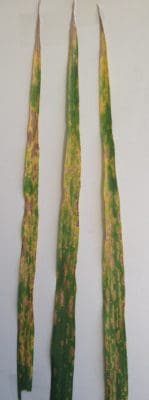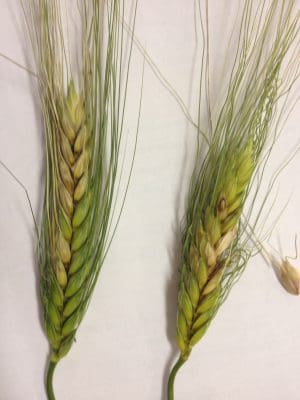NORTHERN NSW durum wheat producers are encouraged to check their crops following the observation of chloride deficiency and general concern around the potential risks of Fusarium head blight in durum wheat crops due to the wet conditions.
NSW Department of Primary Industries (DPI) senior research scientist, Steven Simpfendorfer, based at Tamworth Agricultural Institute, said durum wheat growers were advised to regularly check their crops to confirm whether disease was present before they resorted to fungicide applications.
“Growers are advised that the symptoms of chloride deficiency range from numerous small yellow spots through to larger tan or white spots on the leaves and it is very noticeable at the top of the canopy,” Dr Simpfendorfer said.
“If growers observe unusual spotting in their winter cereal crops they should get a definitive diagnosis to determine whether it is a deficiency or a disease – before going to the expense of applying a fungicide.
“The spotting associated with chloride deficiency appears suddenly in the crop and is distributed throughout the whole canopy. The spots look similar to foliar diseases such as yellow leaf spot, but are associated with a nutrient deficiency in wet seasons, not a pathogen, so fungicide application is not warranted.
“In parts of the north west, chloride concentration is generally lower at shallow soil depths. In high rainfall seasons like we are currently experiencing, the roots of durum wheat plants don’t grow so deeply in the soil, and hence encounter low concentrations of chloride.”
Dr Simpfendorfer said the ongoing wet weather had also increased concerns around the potential development of the fungal disease Fusarium head blight (FHB) in northern durum wheat crops.
“Caused by the fungal pathogen Fusarium graminearum (Fg), FHB can cause significant yield loss, quality reductions and downgrading of grain with all durum wheat varieties being highly susceptible to infection,” he said.
“FHB is a head infection which appears as premature bleaching of individual or several spikelets within a head.
“A preventative fungicide application at the start of flowering can reduce the incidence of infected heads, with Prosaro® being the only registered product for the control of FHB in Australia. However, coverage is still critical to efficacy with twin angled nozzles and a high water volume essential.
“Durum grown on maize stubble or in close proximity to a previous maize crop represents the highest risk for the development of FHB. However, sorghum and all winter cereals also host Fg to a lesser degree than maize.”
Growers can contact Dr Steven Simpfendorfer, 0439 581 672, or email [email protected]
Source: NSW DPI




HAVE YOUR SAY